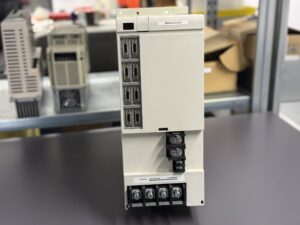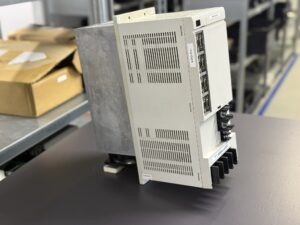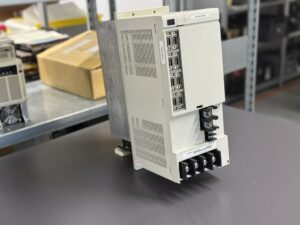10.11.2025 by Viktor Siebert
Repair of a Mitsubishi MDS-B-SPH-300 Spindle Drive Unit the Quality Through Checklists
The Power of Checklists
When a spindle drive of this size arrives on the workbench, concentration and structure are everything.
This MDS-B-SPH-300 was sent in with Overcurrent and Overheat alarms, typical indicators of thermal stress in the power section.
In earlier years, technicians often relied solely on experience. Today, every process step follows a clearly defined checklist. These structured procedures from intake to shipment, have significantly improved both quality and repeatability.
Intake Checklist
Each drive is photographed, serial numbers and error codes are logged, and insulation and continuity are tested before disassembly.
Cleaning Process
All modules are ultrasonically cleaned, dried at 50 °C, and inspected under magnification to detect oxidation or micro-cracks.
Repair Checklist
On average, around 40 components are replaced, from power transistors and gate drivers to capacitors and sensors. Each replacement step is measured, documented, and verified.
Testing Checklist
The drive is then operated on the spindle test bench under load for several hours. Current, torque, and temperature are logged and evaluated. Only when all readings remain stable is the unit cleared for release.
Shipping Checklist
Final cleaning, housing inspection, serial verification, and packaging are all confirmed and signed off before dispatch.
Eight hours of highly focused work, guided by hundreds of checkpoints but the result is consistency, traceability, and trust.
Quality is not coincidence: it is the outcome of discipline and structure.
Preventive Measures for the Customer
- Clean and inspect fans and air channels regularly
- Replace DC-bus capacitors every 5–7 years
- Check connectors and terminals for oxidation
- Clean heatsinks and renew thermal paste
- Inspect encoder cables for shielding and wear
- Perform annual insulation testing
- Protect the drive from moisture and coolant mist
Conclusion
The consistent use of checklists has transformed the repair workflow for complex spindle drives like the MDS-B-SPH-300.
Experience became process, and process became quality.
Every step is documented, every result reproducible and each repaired unit strengthens customer confidence.





To mentioned Mitsubishi Drive: Mitsubishi MDS-B-SPH-300 Spindle Drive Unit
More details about our Mitsubishi repair services can be found here:
Mitsubishi drive Repair by Industrypart
📞 Feel free to contact us with any questions about your Mitsubishi drive technology.
Our expert team is happy to help!
Technical Specifications
| Specification | Value | Remark |
|---|
| Manufacturer | Mitsubishi Electric | Japan |
| Device Type | AC Spindle Drive Unit | MDS-B Series (SPH Type) |
| Input Voltage | 3-phase, 200–230 V AC (±10 %) | 50/60 Hz |
| Output Voltage | 3-phase, 0–200 V AC | Regulated for spindle motor |
| Rated Power | approx. 30 kW | Depending on spindle configuration |
| Rated Current | approx. 160 A | RMS value |
| Cooling | Forced air cooling | Fan and heatsink |
| Control Voltage | 24 V DC | Internal control circuits |
| Weight | approx. 24 kg | Without fan assembly |
| Dimensions | 420 × 300 × 180 mm | Standard module size |
| Design | Modular inverter unit | Part of the MDS-B system |
| Manual Reference | Mitsubishi Spindle Drive Manual MDS-A/SP & MDS-B/SP | Original source |
| Production Period | approx. 1998–2006 | Used in CNC lathes and machining centers |
Application Environment and Compatible Devices
The Mitsubishi MDS-B-SPH-300 is a powerful spindle drive used in vertical machining centers, CNC lathes, and portal milling machines. It is operated in combination with a central power supply unit and communicates with the CNC control via SSCNET.
Compatible Components
- Power Supply Unit: MDS-B-CVE-300 or CVE-185
- CNC Controls: Mitsubishi Meldas M50, M60, M70, M700
- Spindle Motors: Mitsubishi SJ-12, SJ-15, SJ-18, SJ-22
- Interface: SSCNET serial communication
- Cooling: External fan, internal temperature monitoring
Functional Description
The MDS-B-SPH-300 controls spindle torque and speed through precise vector regulation and a shared DC-bus supply that distributes energy between axes and spindle modules.
Main Features
- Real-time current and voltage regulation
- Torque control with encoder feedback
- Regenerative braking with energy recovery
- Multi-level protection for overcurrent, overload, and overtemperature
- Integrated fault diagnostics via LED and CNC interface
The modular structure allows the unit to operate in multi-drive systems and communicate seamlessly with the CNC via SSCNET for real-time process feedback.
Alarm Messages and Troubleshooting (Original Codes from Mitsubishi Manual)
| Code | Description | Cause | Solution |
|---|
| 01 | Overcurrent | Excessive output current or faulty power module | Inspect power transistors and gate driver, remove short circuits |
| 02 | Regenerative Error | Feedback circuit fault or resistor overload | Check regeneration circuit, resistor, and relay |
| 03 | Speed Error | Faulty speed feedback | Inspect encoder signal and cabling |
| 04 | Overvoltage | DC-bus voltage exceeded limit | Verify supply voltage and braking circuit |
| 05 | Overheat | Excessive temperature on heatsink | Inspect fans, airflow, and sensors |
| 06 | Overload | Motor overloaded | Check load and cooling |
| 07 | Power Source Abnormal | Input voltage abnormal | Inspect power supply and main input |
| 08 | Encoder Error | Missing or noisy feedback signal | Inspect encoder and connectors |
| 09 | CPU Error | Processor or clock fault | Replace control board |
| 10 | Memory Error | EEPROM or RAM fault | Replace memory or board |
| 11 | External Signal Error | Faulty enable or start signal | Check input logic and interlocks |
| 12 | Communication Error | SSCNET connection fault | Inspect cable, connector, and termination resistor |
Components
| Module | Designation / Code | Function | Inspection / Repair Notes |
|---|
| Power Board | RD321B-SPH-300 | Main inverter power stage | Visual and isolation testing |
| Control Board | RK311B-SP | Signal processing and gate control | Check solder joints and logic voltages |
| Gate Drive Board | RK124B-SP | IGBT gate driver circuit | Verify isolation and switching signals |
| Cooling Unit | – | Heat dissipation | Measure fan speed and airflow |
| Capacitor Bank | – | DC-bus smoothing | Test capacity, replace if aged |
| Temperature Sensor | – | Monitors transistor temperature | Compare readings to reference values |
| SSCNET Interface | – | CNC communication | Check signal quality and termination |